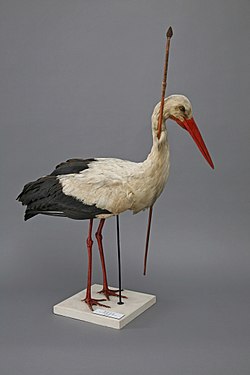From Wikipedia, the free encyclopedia
Migrating stork which has been hit by an arrow

A Pfeilstorch (German for 'arrow stork', pronounced [ˈpfaɪ̯l.ˌʃtɔɐ̯ç]; plural Pfeilstörche, [-ˌʃtœɐ̯.çə]) is a white stork that is injured by an arrow or spear while wintering in Africa and returns to Europe with the projectile stuck in its body. As of 2003, about 25 Pfeilstörche have been documented in Germany.[1]
The first and most famous Pfeilstorch was a white stork found in 1822 near the German village of Klütz, in the state of Mecklenburg-Vorpommern. It was carrying a 75-centimetre (30 in) spear from central Africa in its neck.[2][3] The specimen was subsequently stuffed and can be seen today in the zoological collection of the University of Rostock. It is therefore referred to as the Rostocker Pfeilstorch.[4][5][6]
This Pfeilstorch was crucial in understanding the migration of European birds. Before migration was understood, people struggled to explain the sudden annual disappearance of birds like the white stork and barn swallow. Besides migration, some theories of the time held that they turned into other kinds of birds, mice, or hibernated underwater during the winter, and such theories were even propagated by zoologists of the time.[7][8][9] The Rostocker Pfeilstorch in particular proved that birds migrate long distances to wintering grounds.[10]
Ernst Schüz documented a number of birds with arrows stuck to them: a white-bellied stork collected in Tanganyika, a short-toed eagle in Hungary, a honey buzzard in Finland, and a black kite. He also reported swans and eiders with Inuit arrows. He noted in 1969 that sightings of birds with embedded arrows had declined because of the "unfortunate" replacement of bows and arrows by guns.[11]
- ^ "Der Rostocker Pfeilstorch" [The Rostock Pfeilstorch] (PDF). Der Sprössling. University of Rostock. 2003. pp. 9–10. Archived from the original (PDF) on 13 February 2015.
Mittlerweile sind etwa 25 Fälle bekannt geworden, in denen Weißstörche ganze Pfeile oder Bruchstücke aus Afrika nach Deutschland mitbrachten.
[Since then, around 25 cases wherein white storks have brought with them either entire arrows or fragments from Africa to Germany have become known.] - ^ Fone, Martin (11 January 2020). "Curious Questions: How did a stork with a spear through its neck solve the mystery of the migration of birds?". countrylife.co.uk. Retrieved 18 December 2020.
- ^ Baykal, Hakan (20 May 2022). "Vogelzug: Die wahre Geschichte vom Pfeilstorch" [Bird Migration: The True Story of the Arrow Stork]. spektrum.de (in German). Retrieved 15 November 2022.
- ^ "Zoologische Sammlung der Universität Rostock" (in German). Archived from the original on 2 October 2011.
- ^ "Flyer for the Rostock University Zoological Collection" (PDF). Archived from the original (PDF) on 22 March 2012.
- ^ "Der Sproessling 3" (PDF) (in German). Archived from the original (PDF) on 25 November 2014.
- ^ Cocker, Mark; Mabey, Richard (2005). Birds Britannica. Chatto & Windus. p. 315. ISBN 0-7011-6907-9.
- ^ Pomeroy, Ross (19 February 2018). "The Weirdest Ideas About Bird Migration". www.realclearscience.com. Retrieved 19 December 2019.
- ^ MacDonald, Helen (15 May 2015). "Flight Paths". The New York Times.
- ^ Kinzelbach, Ragnar K. (2005). Das Buch vom Pfeilstorch (in German). Basilisken-Presse. ISBN 3-925347-78-X.
- ^ Schüz, E. (1969). "[Short Notes]. Storks and Other Birds Carrying Arrowheads". Ostrich. 40 (1): 17–. doi:10.1080/00306525.1969.9634321.
- Hagen, H. (1975). "Beobachtung eines Pfeilstorches in Ost-Afrika" [White Stork (Ciconia ciconia) with arrow protruding from its body seen in East Africa]. Ornithologische Mitteilungen (in German). 27 (5): 111–112.
